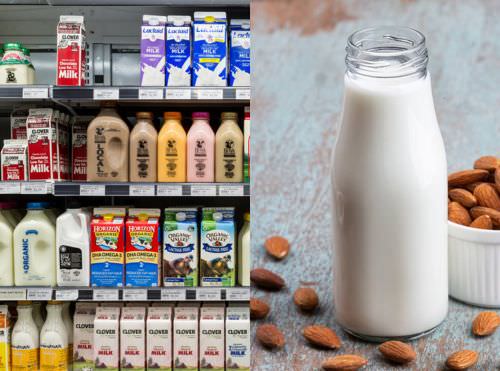From homemade goodness to store-bought delight, the battle of almond milk takes flight! Know which you should choose: Homemade Almond Milk vs Store Bought.
Almond Milk
Almond milk is a plant-based milk alternative that comes from a mix of almonds and water. It’s popular as a dairy-free and vegan option for those who are lactose intolerant, have dairy allergies, or choose to follow a plant-based lifestyle. Almond milk offers a mild, slightly nutty flavor and a creamy texture.
It is infamous for being low in calories and fat, which even makes it a lighter alternative to cow’s milk. It is a good source of vitamin E, an antioxidant that supports cell health, and may contain added calcium and vitamin D for bone health. However, the actual nutritional content can vary between brands and homemade versions, especially in terms of fortification and additional ingredients.
Why Almond Milk?
1. Dietary Restrictions
Almond milk is naturally lactose-free, making it suitable for individuals with lactose intolerance or a dairy allergy. It provides a non-dairy option that one can easily incorporate into various diets.
2. Vegan and Plant-Based Diets
Almond milk is entirely plant-based, making it a staple for vegans and those following a plant-based lifestyle. It can serve as a substitute for cow’s milk in recipes, baking, and beverages as well.
3. Nutritional Profile
Almond milk is generally lower in calories than cow’s milk and contains no saturated fat or cholesterol. You can even fortify homemade almond milk with nutrients like calcium, vitamin D, and vitamin B12 to provide similar nutritional benefits as cow’s milk.
4. Digestive Benefits
Some people find that almond milk is easier to digest in comparison to dairy milk. As cow milk contains lactose, it can cause digestive discomfort in individuals with lactose intolerance. On the contrary, almond milk is naturally free of lactose.
5. Allergen Considerations
Almond milk is a good alternative for individuals with soy or nut allergies since it is soy-free. The biggest advantage is that with homemade almond milk, you can avoid cross-contamination risks.
6. Taste and Versatility
Almond milk has a mild, slightly nutty flavor that many people enjoy. Home cooks and chefs even use it in a wide range of recipes, including smoothies, cereal, coffee, baking, and cooking.
7. Environmental Impact
Almond milk has a lower carbon footprint in comparison to dairy milk production. It requires less water and produces fewer greenhouse gas emissions, making it a more sustainable choice.
Homemade Almond Milk vs Store Bought
Here’s a comparison between Homemade Almond Milk and Store-Bought Almond Milk:
| Basis | Homemade Almond Milk | Store-Bought Almond Milk |
| Ingredients | You can add almonds, water, optional sweeteners, and flavor. | It contains almonds, water, emulsifiers, stabilizers, sweeteners, and flavor. |
| Freshness | Since it’s made at home, its fresh and you can consume it immediately. | Due to added preservatives, it might not be as fresh and will have a longer shelf life. |
| Taste | You can customize it as per personal preference. | It has a consistent flavor profile, and may have added flavors. |
| Texture | It has a creamier and smoother texture. | The consistency may vary from package to package. |
| Nutritional Content | It contains more nutrients and enzymes. | Fortified with vitamins and minerals, but may have additives. |
| Cost | Bulk batches could be more cost-effective. | It might be convenient but can be more expensive. |
| Additives and Preservatives | None, unless you decide to add artificial flavors and sweeteners. | May contain emulsifiers, stabilizers, and sweeteners. |
| Environmental Impact | It requires little to no packaging, which reduces carbon footprint. | Packaging waste, that may pose potential environmental concerns. |
| Customization Options | You can adjust sweetness, thickness, and flavors. | There are limited flavors and options available. |
| Preparation Time | Requires soaking almonds and straining. | Ready to use, no soaking required. |
It’s important to note that the specific characteristics of homemade and store-bought almond milk may vary depending on the brand and the specific ingredients used. Homemade almond milk offers the advantage of customization and freshness, while store-bought options provide convenience and longer shelf life.
Why Prefer Homemade Almond Milk
There are several reasons why some people may prefer homemade almond milk over store-bought options:
- Freshness and Taste: When you make almond milk at home, you have control over the ingredients and customize flavors as per your preference. This will give you an opportunity to get a fresher taste in comparison to the store-bought versions, which may contain added flavors or preservatives.
- Nutritional Content: Since you’ll be able to customize the milk as per your preference, you can avoid additives and sweeteners. This allows the preservation of the natural nutrients and enzymes that almonds have.
- Customization and Control: You can adjust the sweetness, thickness, and flavor profile of the milk, which you’ll not be able to do in store-bought versions. You can experiment with different ratios of almonds to water and even add natural sweeteners or flavors if desired.
- Reduced Additives: Store-bought versions contains emulsifiers, stabilizers, and sweeteners that enhance taste, texture, and shelf life. By making your own batch, you can eliminate or minimize these additives, promoting a cleaner and more natural product.
- Cost-Effective: Making almond milk at home is more cost-effective, especially when you make them in bulk. Almonds are generally less expensive than store-bought almond milk, allowing you to save money over time.
- Environmental Considerations: Homemade almond milk helps reduce packaging waste associated with store-bought options. By using reusable containers and buying almonds in bulk, you can minimize your environmental footprint.
Almond Milk Recipe
To make almond milk at home, follow these steps:
Ingredients:
- 1 cup of raw almonds
- 4 cups of water (plus more for soaking)
- Optional: Sweeteners like dates, honey, or maple syrup
- Optional: Flavorings like vanilla extract or cocoa powder
Instructions:
- Place the almonds in a bowl and cover them with water. Let them soak overnight or for at least 8 hours. This process helps soften the almonds and makes them easier to blend.
- Once the almonds are soaked, drain and rinse them thoroughly under cool running water.
- Put the almonds into a blender and add 4 cups of fresh water and any optional sweeteners or flavorings if desired. Blend on high speed for about 2-3 minutes until you get a smooth, creamy mixture.
- Place a nut milk bag, cheesecloth, or fine mesh strainer over a large bowl or pitcher. Slowly pour the blended almond mixture into the strainer. Gently squeeze or press the mixture to extract as much milk as possible. This will leave behind the almond pulp.
- If you prefer a smoother texture, strain the milk once more using a fresh nut milk bag or strainer.
- Pour the strained almond milk into a clean jar or bottle. Seal it tightly and refrigerate for up to 4-5 days. Shake well before using, as separation may occur.
Note: You can use the leftover almond pulp in various recipes, such as baked goods or granola.
Enjoy your homemade almond milk in smoothies, coffee, cereal, or as a refreshing drink on its own! Remember to adjust the sweetness and flavorings according to your preference.
Takeaway
Almond milk can be a nutritious choice as part of a balanced diet, but its specific benefits and drawbacks depend on factors such as the brand, fortification, and individual dietary needs.
It’s important to note that almond milk is not suitable for those with nut allergies. If you have specific dietary concerns or nutritional needs, it’s advisable to read product labels. Choose unsweetened or fortified options, and consult with a healthcare professional or registered dietitian for personalized advice.




